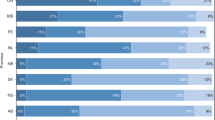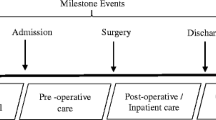Abstract
Background
There is increasing recognition that lower nurse staffing levels are associated with higher morbidity and mortality among medical and surgical patients. The degree to which this applies to elderly patients with hip fractures is unclear.
Questions/purposes
We conducted a pilot study using administrative data as an initial step in investigating the relationship between nurse staffing levels and in-hospital mortality among elderly patients with hip fractures.
Patients and Methods
We retrospectively reviewed administrative data for 13,343 patients 65 years or older with a primary diagnosis of hip fracture admitted to 39 Michigan hospitals between 2003 and 2006. We used logistic regression to calculate the change in predicted probability of in-hospital death conferred by differences in the hospitals’ overall number of full-time equivalent registered nursing staff (FTE-RN) per patient day. Regression models controlled for patient age, gender, and comorbid conditions; hospital characteristics including teaching status, hip fracture volume, and income/racial composition of the hospital’s zip code; and seasonal influenza.
Results
We found an association between hospital-wide nurse staffing levels and in-hospital mortality among patients with hip fractures. The odds of in-hospital mortality decreased by 0.16 for every additional FTE-RN added per patient day, even after controlling for covariates. This association suggests the absolute risk of mortality increases by 0.35 percentage points for every one unit decrease of FTE-RN per patient day, a 16% increase in the risk of death.
Conclusions
Decreased hospital-wide nurse staffing levels are associated with increased in-hospital mortality among patients admitted with hip fractures. These observations indicate the need for further studies to characterize this relationship for staffing of units caring for patients with hip fractures.
Level of Evidence
Level III, prognostic study. See Guidelines for Authors for a complete description of levels of evidence.
Similar content being viewed by others
References
Agency for Healthcare Research and Quality (AHRQ). Overview of the Heathcare Cost and Utilization Project’s (HCUP) State Inpatient Databases (SID). Available at: http://www.hcup-us.ahrq.gov/sidoverview.jsp. Accessed March 29, 2011.
Agency for Healthcare Research and Quality (AHRQ). AHRQ Quality Indicators–Guide to Inpatient Quality Indicators: Quality of Care in Hospitals–Volume, Mortality, and Utilization. Rockville, MD: Agency for Healthcare Research and Quality; 2002. Revision 4 (December 22, 2004). AHRQ Pub. No. 02-RO204.
Aharonoff GB, Koval KJ, Skovron ML, Zuckerman JD. Hip fractures in the elderly: predictors of one year mortality. J Orthop Trauma. 1997;11:162–165.
Aiken LH, Clarke SP, Sloane DM, Sochalski J, Silber JH. Hospital nurse staffing and patient mortality, nurse burnout, and job dissatisfaction. JAMA. 2002;288:1987–1993.
Al-Ani AN, Samuelsson B, Tidermark J, Norling A, Ekstrom W, Cederholm T, Hedstrom M. Early operation on patients with a hip fracture improved the ability to return to independent living: a prospective study of 850 patients. J Bone Joint Surg Am. 2008;90:1436–1442.
Al-Rashid M, Parker MJ. Anticoagulation management in hip fracture patients on warfarin. Injury. 2005;36:1311–1315.
American Hospital Association (AHA). Annual Survey of Hospitals 2003–2006. Chicago, IL: American Hospital Association; 2006.
American Hospital Association (AHA). American Hospital Association - National Providers Identifiers (AHA-NPI) Crosswalk. Chicago, IL: American Hospital Association; 2008.
Beaupre LA, Jones CA, Saunders LD, Johnston DW, Buckingham J, Majumdar SR. Best practices for elderly hip fracture patients: a systematic overview of the evidence. J Gen Intern Med. 2005;20:1019–1025.
Bhattacharyya T, Iorio R, Healy WL. Rate of and risk factors for acute inpatient mortality after orthopaedic surgery. J Bone Joint Surg Am. 2002;84:562–572.
Cameron ID, Handoll HH, Finnegan TP, Madhok R, Langhorne P. Co-ordinated multidisciplinary approaches for inpatient rehabilitation of older patients with proximal femoral fractures. Cochrane Database Syst Rev. 2001:CD000106.
Centers for Disease Control and Prevention (CDC). Seasonal influenza - flu activity and surveillance. Available at: http://www.cdc.gov/flu/weekly/fluactivity.htm. Accessed July 20, 2008.
Clifton R, Haleem S, McKee A, Parker MJ. Closed suction surgical wound drainage after hip fracture surgery: a systematic review and meta-analysis of randomised controlled trials. Int Orthop. 2008;32:723–727.
Cumming D, Parker MJ. Urinary catheterisation and deep wound infection after hip fracture surgery. Int Orthop. 2007;31:483–485.
Elixhauser A, Steiner C, Harris DR, Coffey RM. Comorbidity measures for use with administrative data. Med Care. 1998;36:8–27.
Elting LS, Pettaway C, Bekele BN, Grossman HB, Cooksley C, Avritscher EB, Saldin K, Dinney CP. Correlation between annual volume of cystectomy, professional staffing, and outcomes: a statewide, population-based study. Cancer. 2005;104:975–984.
Freeman C, Todd C, Camilleri-Ferrante C, Laxton C, Murrell P, Palmer CR, Parker M, Payne B, Rushton N. Quality improvement for patients with hip fracture: experience from a multi-site audit. Qual Saf Health Care. 2002;11:239–245.
Handoll HH, Sherrington C, Parker MJ. Mobilisation strategies after hip fracture surgery in adults. Cochrane Database Syst Rev. 2004:CD001704.
Hosmer DW, Lemeshow S. Applied Logistic Regression. New York, NY: Wiley; 2000.
Johnston P, Wynn-Jones H, Chakravarty D, Boyle A, Parker MJ. Is perioperative blood transfusion a risk factor for mortality or infection after hip fracture? J Orthop Trauma. 2006;20:675–679.
Kane RL Shamliyan T, Mueller C, Duval S, Wilt T. Nursing Staffing and Quality of Patient Care. Evidence Report/Technology Assessment No. 151 (Prepared by the Minnesota Evidence-based Practice Center under Contract No. 290-02-0009.) AHRQ Publication No. 07-E005. Rockville, MD: Agency for Healthcare Research and Quality. March 2007. Available at: http://www.ahrq.gov/clinic/tp/nursesttp.htm. Accessed January 1, 2011.
Kane RL, Shamliyan TA, Mueller C, Duval S, Wilt TJ. The association of registered nurse staffing levels and patient outcomes: systematic review and meta-analysis. Med Care. 2007;45:1195–1204.
Magaziner J, Lydick E, Hawkes W, Fox KM, Zimmerman SI, Epstein RS, Hebel JR. Excess mortality attributable to hip fracture in white women aged 70 years and older. Am J Public Health. 1997;87:1630–1636.
Magaziner J, Simonsick EM, Kashner TM, Hebel JR, Kenzora JE. Predictors of functional recovery one year following hospital discharge for hip fracture: a prospective study. J Gerontol. 1990;45:M101–M107.
Mark BA, Harless DW, McCue M. The impact of HMO penetration on the relationship between nurse staffing and quality. Health Econ. 2005;14:737–753.
Mark BA, Harless DW, McCue M, Xu Y. A longitudinal examination of hospital registered nurse staffing and quality of care. Health Serv Res. 2004;39:279–300.
Michigan Health and Hospital Association (MHA). Michigan Inpatient Database 2003–2006. Lansing, MI: Michigan Health and Hospital Association; 2006.
Morris AH, Zuckerman JD; AAOS Council of Health Policy and Practice, USA. American Academy of Orthopaedic Surgeons. National consensus conference on improving the continuum of care for patients with hip fracture. J Bone Joint Surg Am. 2002;84:670–674.
Needleman J, Buerhaus P, Mattke S, Stewart M, Zelevinsky K. Nurse-staffing levels and the quality of care in hospitals. N Engl J Med. 2002;346:1715–1722.
Orosz GM, Magaziner J, Hannan EL, Morrison RS, Koval K, Gilbert M, McLaughlin M, Halm EA, Wang JJ, Litke A, Silberzweig SB, Siu AL. Association of timing of surgery for hip fracture and patient outcomes. JAMA. 2004;291:1738–1743.
Parker MJ, Handoll HH, Griffiths R. Anaesthesia for hip fracture surgery in adults. Cochrane Database Syst Rev. 2004:CD000521.
Parker MJ, Pryor GA. The timing of surgery for proximal femoral fractures. J Bone Joint Surg Br. 1992;74:203–205.
Pedersen SJ, Borgbjerg FM, Schousboe B, Pedersen BD, Jorgensen HL, Duus BR, Lauritzen JB; Hip Fracture Group of Bispebjerg Hospital. A comprehensive hip fracture program reduces complication rates and mortality. J Am Geriatr Soc. 2008;56:1831–1838.
Perez JV, Warwick DJ, Case CP, Bannister GC. Death after proximal femoral fracture: an autopsy study. Injury. 1995;26:237–240.
Ray NF, Chan JK, Thamer M, Melton LJ 3rd. Medical expenditures for the treatment of osteoporotic fractures in the United States in 1995: report from the National Osteoporosis Foundation. J Bone Miner Res. 1997;12:24–35.
Robertson RH, Hassan M. Staffing intensity, skill mix and mortality outcomes: the case of chronic obstructive lung disease. Health Serv Manage Res. 1999;12:258–268.
Sander B, Elliot-Gibson V, Beaton DE, Bogoch ER, Maetzel A. A coordinator program in post-fracture osteoporosis management improves outcomes and saves costs. J Bone Joint Surg Am. 2008;90:1197–1205.
Siegmeth AW, Gurusamy K, Parker MJ. Delay to surgery prolongs hospital stay in patients with fractures of the proximal femur. J Bone Joint Surg Br. 2005;87:1123–1126.
Silber JH, Kennedy SK, Even-Shoshan O, Chen W, Koziol LF, Showan AM, Longnecker DE. Anesthesiologist direction and patient outcomes. Anesthesiology. 2000;93:152–163.
Simonsen L, Fukuda K, Schonberger LB, Cox NJ. The impact of influenza epidemics on hospitalizations. J Infect Dis. 2000;181:831–837.
Spetz J, Donaldson N, Aydin C, Brown DS. How many nurses per patient? Measurements of nurse staffing in health services research. Health Serv Res. 2008;43:1674–1692.
United States Census Bureau. American FactFinder. Census 2000. Available at: http://factfinder.census.gov. Accessed December 7, 2009.
Urwin SC, Parker MJ, Griffiths R. General versus regional anaesthesia for hip fracture surgery: a meta-analysis of randomized trials. Br J Anaesth. 2000;84:450–455.
Vidan M, Serra JA, Moreno C, Riquelme G, Ortiz J. Efficacy of a comprehensive geriatric intervention in older patients hospitalized for hip fracture: a randomized, controlled trial. J Am Geriatr Soc. 2005;53:1476–1482.
White BL, Fisher WD, Laurin CA. Rate of mortality for elderly patients after fracture of the hip in the 1980’s. J Bone Joint Surg Am. 1987;69:1335–1340.
Wolinsky FD, Fitzgerald JF, Stump TE. The effect of hip fracture on mortality, hospitalization, and functional status: a prospective study. Am J Public Health. 1997;87:398–403.
Zuckerman JD, Skovron ML, Koval KJ, Aharonoff G, Frankel VH. Postoperative complications and mortality associated with operative delay in older patients who have a fracture of the hip. J Bone Joint Surg Am. 1995;77:1551–1556.
Author information
Authors and Affiliations
Corresponding author
Additional information
Each author certifies that he or she has no commercial associations (eg, consultancies, stock ownership, equity interest, patent/licensing arrangements, etc.) that might pose a conflict of interest in connection with the submitted article.
Each author certifies that his or her institution approved or waived approval for the human protocol for this investigation and that all investigations were conducted in conformity with ethical principles of research.
Appendix 1. Results of logistic regression model
Appendix 1. Results of logistic regression model
About this article
Cite this article
Schilling, P., Goulet, J.A. & Dougherty, P.J. Do Higher Hospital-wide Nurse Staffing Levels Reduce In-hospital Mortality in Elderly Patients with Hip Fractures: A Pilot Study. Clin Orthop Relat Res 469, 2932–2940 (2011). https://doi.org/10.1007/s11999-011-1917-8
Received:
Accepted:
Published:
Issue Date:
DOI: https://doi.org/10.1007/s11999-011-1917-8




